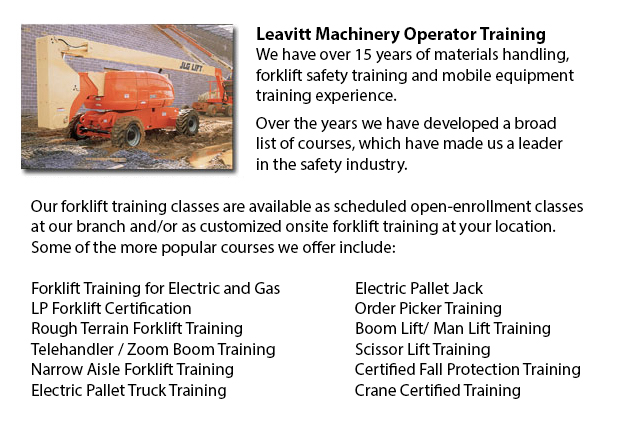
Prince Albert Aerial Lift Safety Training - There are roughly 26 to 30 construction fatalities in North America attributed to the utilization of aerial lifts. Most of those killed are craftsmen like for example laborers, painters, electrical workers, ironworkers or carpenters. Nearly all deaths are caused by tip-overs, electrocutions and falls. The greatest danger is from boom-supported lifts, like for instance cherry pickers and bucket trucks. The majority of the fatalities are related to this particular kind of lift, with the rest involving scissor lifts. Other hazards consist of being thrown out of a bucket, being struck by falling things, and being caught between the lift bucket or guardrail and a thing, like for example a joist or steel beam.
To safely operate an aerial lift, perform a check on the following items prior to utilizing the device: operating and emergency controls, safety devices (such as, outriggers and guardrails), personal fall protection gear, and tires and wheels. Inspect for possible leaks in the air, hydraulic fluid and fuel-system. Inspect the device for loose or missing components.
The location where the device will be used should be carefully inspected for possible dangers, like for example bumps, holes, drop-offs and debris. Overhead power lines should be avoided or closely monitored. It is recommended that aerial lift devices be used on stable, level surfaces. Never work on steep slopes that exceed slope limits that the manufacturer specified. Even on a level slope, wheel chocks, outriggers and brakes must be set.
Businesses should provide their aerial lift operators with the right instruction manuals. Mechanics and operators should be trained by a licensed individual experienced with the relevant type of aerial lift.
Aerial Lift Safety Guidelines:
o Before operating, close lift platform chains and doors.
o Do not lean over or climb on guardrails. Stand on the platform or floor of the bucket.
o Stay within manufacturer's load-capacity limitations.
o When working near traffic, use right work-zone warnings, like for instance cones and signs.
If right procedures are followed, electrocutions are preventable. Stay at least ten feet away from whatever power lines and certified electricians must de-energize and/or insulate power lines. Those working need to make use of personal protective tools and equipment, like insulated bucket. Nonetheless, a bucket that is insulated does not protect from electrocution if, for instance, the worker touches another wire providing a path to the ground.
Falls are preventable if the person working remains secure within guardrails or inside the bucket by utilizing a positioning device or a full-body harness. If there is an anchorage within the bucket, a positioning belt together with a short lanyard is adequate.
By following the manufacturer's directions, tip-overs could be avoided. Never drive the lift platform while it is elevated, unless otherwise specified by the manufacturer. Adhere to the device's horizontal and vertical reach limits, and never go beyond the specified load-capacity.
-
Prince Albert Forklift Training Courses
Prince Albert Forklift Training Courses - When forklift operator safety training is tailored for illiteracy, training time is lessened by 50 percent. Lift-truck operator driver safety training evaluation, train the trainer and forklift training certi... More -
Prince Albert Heavy Equipment Training
Prince Albert Heavy Equipment Training - The two most common kinds of heavy equipment training are classed into the categories of equipment; equipment which is fashioned with rubber tires or those with tracks. The tracked vehicle are heavy duty machi... More -
Prince Albert Order Picker License
Prince Albert Order Picker License - Order preparation operation or order picking as it is more usually known is a method utilized within warehouse operations and comprises staff called order pickers. The order picker's duty is to take and collect ar... More -
Operator Safety Training, Re-Qualification Training, In-House Instructor Training in Prince Albert
Used in nearly all warehouse operations, boat yards or industrial construction sites, the lift truck is a very important part to be able to help raise and transfer cargo. The reach feature of a lift truck can help improve the applications which the f... More -
Prince Albert Overhead Crane Certification
Prince Albert Overhead Crane Certification - The overhead crane training certification program is designed to be effective with all those participating regardless of language or literacy restrictions. The course has two parts: a practical training se... More -
Prince Albert Heavy Equipment Training Programs
Prince Albert Heavy Equipment Training Programs - There are different types of equipment that are ready to be utilized at any given time on a construction site. These equipment require mechanics to be able to complete the maintenance tasks, operators... More -
Prince Albert Crane Operator Certification
Prince Albert Crane Operator Certification - The process to allow individuals to operate specific kinds of cranes is to take crane operator certification training to be given certification. The certification process consists of classroom learning, ha... More -
Prince Albert Crane Safety Training
Prince Albert Crane Safety Training - Both crane driver as well as their employers should know all the possible issues associated to the use of an overhead crane. All over North America, there is legislation that provides regulation for the safe oper... More

Forklift Certification Prince Albert
TOLL FREE: 1-888-254-6157
Prince Albert, Saskatchewan
forkliftcertificationprincealbert.com
Email Us
About Us


